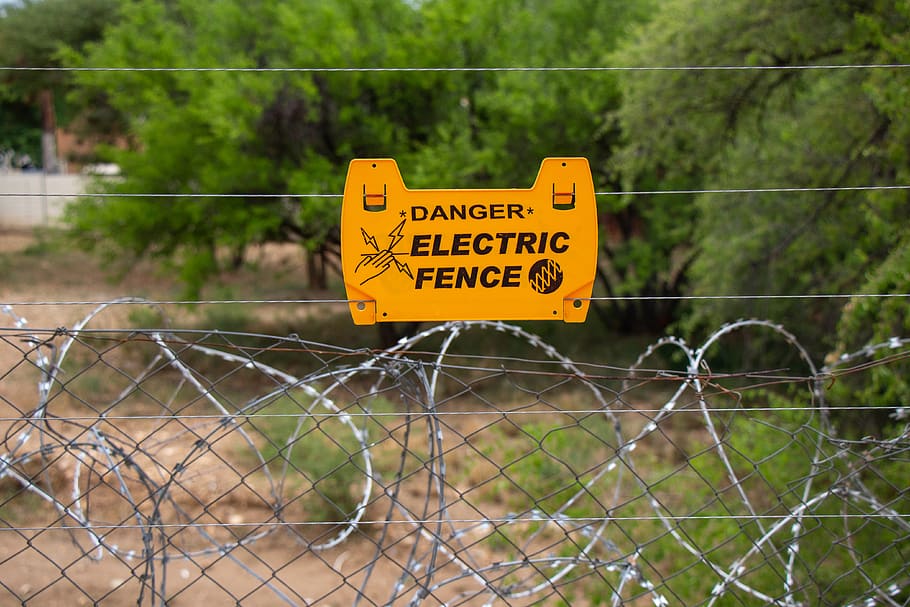
Electric Fence: Understanding Electric Fence Grid Wires
Electric fence seems like a complex type of high-security fence, but the truth is, when you break it all down into the basic parts, it’s not that complicated.
electric security fence systems consist of two main parts: the wires that carry the charge on the fence (also known as electric fence grid wires) and the energizer equipment that powers it. In this article, we’re going to look at the electric fence grid wires and the components you will need to create the body of your electric fence.
Tension Posts
Like most types of fence, there are tension posts and line posts in most security electric fences. These types of posts usually have different types of equipment, with the fittings used on tension posts designed to both strain and insulate and the fittings on line posts primarily designed to insulate. Here are the main fittings you can expect to see on electric fence tension posts:
Offset BracketsIn some parts of the world, offset brackets might be used on electric fences to allow for the installation of electric fence wires without drilling into the post itself. These can be eliminated by using a post that does not trap water, like an angle iron post. |
||
Strain InsulatorsStrain insulators are used at the end of each line of electric fence to ensure that the current from the fence does not electrify the post itself. These insulators are made to handle the tension on the electric fence wires. |
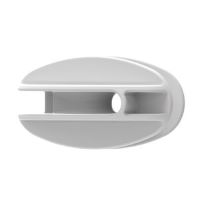 |
|
Ratchet Style TensionersThere are many types of wire tensioners you can use on your terminal posts, but the best options always have a built-in ratchet mechanism so that the wire remains taut when tensioned. Ratchet-style tensioners are usually only needed at one side of a fence line or on one side of a corner or in-line tension post. |
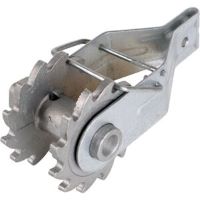 |
|
wire Loopswire loops are not something you purchase for electric fence installations, but rather, pieces of wire that are used to “bridge” wires, either vertically to create the live out / live return and earth out / earth return circuit of electric fence systems. Wire loops might be very simple, but they are critical to creating a functioning circuit, which is essential for a working electric fence. |
||
Line ClampsBecause wire loops are so important to electric fence functionality, most good electric fence installers do not rely on wire twists alone to keep loops in place. Line clamps are often used to ensure that there’s a tight, secure connection between your fence wires. |
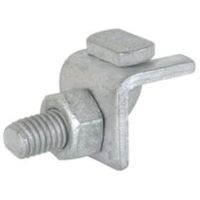 |
Line Posts
Line post electric fence equipment is a lot simpler than what you would expect to see on an electric fence terminal post, but that does not mean it’s any less important.
Every wire on every fence post on your electric fence must be properly insulated in order to prevent short circuits, which could cause false alarms on your fence, and might even make your fence dangerous or less functional – neither of which are great!
Offset BracketsAs with electric fence tension posts, if you are installing an electric fence in a colder climate and you are using tubular posts, you may need to install offset brackets on your fence to eliminate the need for drilling into your fence posts. Use an angle iron or another open steel profile to avoid using offset brackets. |
||
InsulatorsUnlike strain insulators, line post insulators are not under any tension, so their primary function is to keep wires properly spaced and away from the fence structure. This prevents the current from the fence wires from traveling into the fence posts, preventing shorts and ensuring that the fence structure does not become live. |
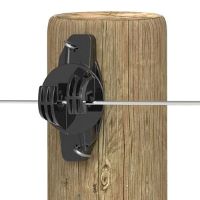 |
|
Screws, Rivets, or NailsThe type of hardware you will use to install your insulators depends on the type of post or bracket they are being attached to. Self-drilling screws work well for on-site installation, but if you pre-drill holes for your insulators, rivets are a cost-effective alternative. If your fence posts are wood, you can also use an appropriately sized nail to attach your insulators. |
Electric Fence Wires
The last big element of your electric fence grid wires is the wire itself.
There are many different types of wire that can be used for electric fences, ranging from galvanized high tensile wire to stainless steel in various grades, aluminum, and others.
Different types of wires have different price points, and they will also have different anti-corrosion properties, conductivity, and more.
Most electric fence energizers specify how much electric fence wire they can power – usually expressed by the single linear meter or foot. So make sure you calculate how much wire you are using in total and plan your energizers accordingly.
Electric Fence WireElectric fence wires carry the charge from the energizer around your fence line and, if you are monitoring the fence for shorts or tampering, back to your energizer and your electric fence management system. Many different types of wires can be used, but since this is such an important part of your electric fence’s functionality, you should always take care to buy the best quality wire you can afford for your fence. While you can have electric fences with a different number of strands, they usually have even numbers of wires to allow for the wire to go out and return to close the circuit. |
 |
|
Warning SignsThe vast majority of electric fences around the world today are non-lethal. That means that they won’t kill people or animals that accidentally touch them. However, that does not mean that you should go around touching electric fences! In fact, most places that allow electric fence installation require that you install warning signs on your fence to alert passersby that the fence is electrified. |
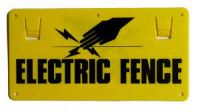 |
A Predictable Design
We hope that our guide to the materials and design involved in most electric fence grid wire systems has made it a little easier to understand how your electric fence works and what you will need to construct it.
The good news is that once you understand how electric fence systems work, the design for each fence is fairly predictable. Even though the number of wire strands, zones, and other features might differ, the fence will still be constructed using the same basic equipment.


